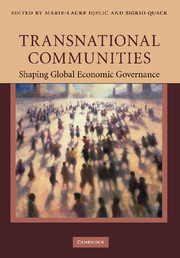Book contents
- Frontmatter
- Contents
- List of figures
- List of tables
- List of appendices
- Contributors
- Preface
- Part I Introduction
- Part II Classical communities with a transnational extension
- 3 The multiple layers of a transnational “imagined community”: the notion and reality of the ethnic Chinese business community
- 4 From cross-border exchange networks to transnational trading practices? The case of shuttle traders in Laleli, Istanbul
- Part III Professional communities with a transnational extension
- Part IV Virtual communities
- Part V Transnational interest- or issue-based communities
- Part VI Conclusion
- Index
- References
4 - From cross-border exchange networks to transnational trading practices? The case of shuttle traders in Laleli, Istanbul
Published online by Cambridge University Press: 07 September 2010
- Frontmatter
- Contents
- List of figures
- List of tables
- List of appendices
- Contributors
- Preface
- Part I Introduction
- Part II Classical communities with a transnational extension
- 3 The multiple layers of a transnational “imagined community”: the notion and reality of the ethnic Chinese business community
- 4 From cross-border exchange networks to transnational trading practices? The case of shuttle traders in Laleli, Istanbul
- Part III Professional communities with a transnational extension
- Part IV Virtual communities
- Part V Transnational interest- or issue-based communities
- Part VI Conclusion
- Index
- References
Summary
This chapter investigates the complexities inherent in the organization of economic activity within the context of transnational communities by focusing on the interplay between Istanbul's garment producers, shopkeepers, and so-called “shuttle traders” (mostly from the post-Soviet republics) in Laleli (a district of central Istanbul). These traders have played an active role in the emergence of an informal transnational economy in the district since the early 1990s. An in-depth analysis of the case of Laleli and the complex web of relationships between producers, shopkeepers, and shuttle traders allows us to comment on the features of a constantly changing marketplace which is highly informal as well as transnational in character, with social, spatial, organizational, and economic dimensions. What kind of formal and informal trading networks, for instance, emerge as our gaze shifts from small garment producers and shopkeepers in Istanbul to shuttle traders and kiosk managers in Russia? What kind of dynamics evolve through these transnational encounters shaping networks and markets? Do such activities trigger the emergence of a transnational community by means of the Laleli market? If they do, what sort of transnational community is evolving there and why? Only by addressing such questions, we suggest, can we begin to develop a better understanding of the formation and dissolution of transnational communities and their impact on the political and economic landscape.
- Type
- Chapter
- Information
- Transnational CommunitiesShaping Global Economic Governance, pp. 82 - 104Publisher: Cambridge University PressPrint publication year: 2010
References
- 5
- Cited by



